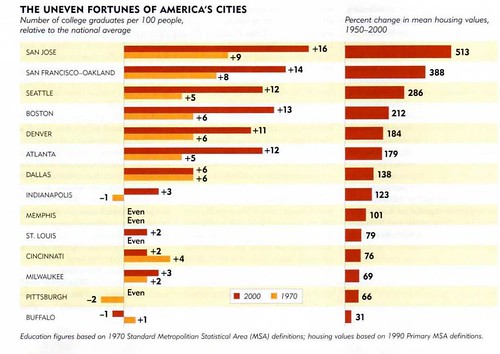Richard Florida collected some data. Doesn't look good for Buffalo, NY. It was Tom Yorty from Westminster who mentioned Florida's recent article, Where the Brains Are [pdf] the other day. Florida's work appears in the most recent issue of the Atlantic Monthly, October 2006. First time I've ever seen the data presented like this. Education and housing values.
Two additional images from the article - 1970 and 2000 - depict the migration of college graduates over the last thirty years. Hard to believe that Buffalo once supported such intellectual heavy weights as Richard Hofstadter and Harry Emerson Fosdick.Richard Florida's work has been celebrated recently in Buffalo, NY - right here. It certainly seems as though his analysis is beginning to merge with what Joel Kotkin has said in - Rise of the Ephemeral City.
Trends. Tough stuff to overcome. Long slow slog.
__________________________________________________________________________
Artspace Archive • Annals of Neglect • BAVPA • Where is Perrysburg? • Broken Promises...
Writing the City • Woodlawn Row Houses • Tour dé Neglect - 2006 • faq • my flickr
Artspace Archive • Annals of Neglect • BAVPA • Where is Perrysburg? • Broken Promises...
Writing the City • Woodlawn Row Houses • Tour dé Neglect - 2006 • faq • my flickr


7 comments:
Kotkin is still very much anti-Florida. Check out his most recent (excellent) essay in Democracy -- A Journal of Ideas.
http://www.democracyjournal.org/article.php?ID=6483
Anon,
...here's the link - Urban Legend.
Just started reading that, thanks!
Just looking at the table, I cannot help but think that something is missing, since Buffalo has more institutions of higher learning per capita than most of the higher-ranking cities. I can't put my finger on it so I'll have to read Florida's article when I have more time.
Could be a whole host of reason why this is off. I'm not a Florida fan because his analysis always seem to support his own beliefs and ideas and he focuses on areas that prove what hje saying but never a look at areas where it isn't the case.
Anyway, as a master's grad in urban planning and someone involved in housing, and without the numbers, my sense is that the increase in housing cost might seem high but that's only because it was low to begin with. For example, I think the mean is around $90-$95 -ish. Very reasonable homes here. Anyway, it otder to get a 31% increase, it the difference roughly between $70 and $90 thousand. In real dollars, over 36 years, that's a small and affordable increase. That's actually a good thing for this area because it means that middle class and lower classes of people can own a home. Florida probably thinks it's an indication of the apocalypse.
Florida's ego runneth over, and his tables are meaningless.
Hank Bromley sent this in - the underlying study to Florida's piece in the Atlantic Monthly.
Superstar Cities [pdf] by Joseph Gyourko, Christopher Mayer, Todd Sinai NBER Working Paper No. 12355
Issued in July 2006
Here's the abstract...
Differences in house price and income growth rates between 1950 and 2000 across metropolitan areas have led to an ever-widening gap in housing values and incomes between the typical and highest-priced locations. We show that the growing spatial skewness in house prices and incomes are related and can be explained, at least in part, by inelastic supply of land in some attractive locations combined with an increasing number of high-income households nationally. Scarce land leads to a bidding-up of land prices and a sorting of high-income families relatively more into those desirable, unique, low housing construction markets, which we label
"superstar cities." Continued growth in the number of high-income families in the U.S. provides support for ever-larger differences in house prices across inelastically supplied locations and income-based spatial sorting. Our empirical work confirms a number of equilibrium relationships implied by the superstar cities framework and shows that it occurs both at the metropolitan area level and at the sub-MSA level, controlling for MSA
characteristics.
dennyk
explain
Post a Comment